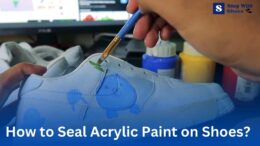To seal acrylic paint on shoes, use a clear acrylic sealer spray for a durable and long-lasting finish. We will discuss the steps to properly seal acrylic paint on shoes, ensuring that your artwork stays intact even with regular wear and tear.
Whether you are customizing your own shoes or looking to protect a painted design, the sealing process is crucial to maintain the vibrant colors and prevent them from cracking or peeling. By following these steps, you can effectively seal your acrylic paint on your shoes and enjoy your wearable artwork for a long time.
Choosing The Right Shoes And Materials
Factors To Consider When Selecting Shoes For Painting
When it comes to customizing shoes with acrylic paint, choosing the right shoes is essential for achieving the best results. Here are some factors to consider when selecting shoes for painting:
- Material: Opt for shoes made of canvas or leather, as they are the most suitable for painting with acrylics. These materials provide a smooth surface that allows the paint to adhere well and last longer.
- Condition: Ensure that the shoes are clean and free from any dirt, dust, or previous coatings. A clean surface helps the paint bond better and prevents any unwanted textures or bumps.
- Style and design: Select plain or minimal shoes, without intricate patterns or textures. This gives you more freedom to unleash your creativity and create a unique design.
Recommended Types Of Acrylic Paint For Shoe Customization
When it comes to acrylic paint for customizing shoes, not all paints are created equal. Here are some recommended types of acrylic paint to use:
- Acrylic leather paint: Specifically formulated for leather surfaces, this type of paint provides excellent adhesion and flexibility. It is ideal for painting leather shoes and ensures a long-lasting finish.
- Fabric paint: Suitable for canvas shoes, fabric paint is specially designed to withstand wear and tear. It offers vibrant colors and flexibility, allowing the shoes to bend without cracking the paint.
- Acrylic paint with fabric medium: If you have regular acrylic paint on hand, you can mix it with a fabric medium. This helps the paint adhere to fabric surfaces better and provides good durability.
Essential Tools And Materials For Sealing Acrylic Paint On Shoes
Sealing the acrylic paint on shoes is crucial to protect the design and ensure its longevity. Here are some essential tools and materials you will need for this process:
- Paintbrushes or sponge brushes: Choose brushes with synthetic bristles, as they work well with acrylic paint. Sponge brushes are great for applying an even coat of sealant.
- Acrylic sealant or finisher: Look for a sealant specifically designed for acrylic paint. It should be waterproof, flexible, and provide a clear, glossy or matte finish.
- Masking tape or painter’s tape: Use these tapes to cover any areas you don’t want to seal, such as soles or laces.
- Soft cloth or sponge: These are handy for removing any excess paint or cleaning the shoes before sealing.
- Well-ventilated area: Ensure you work in a well-ventilated space or outdoors, as sealants can emit strong fumes.
Remember to follow the manufacturer’s instructions when using these tools and materials to seal your acrylic paint on shoes. A proper sealant application will protect your design from fading, cracking, or peeling, allowing you to enjoy your custom shoes for a long time.
sealing acrylic paint on different types of shoes
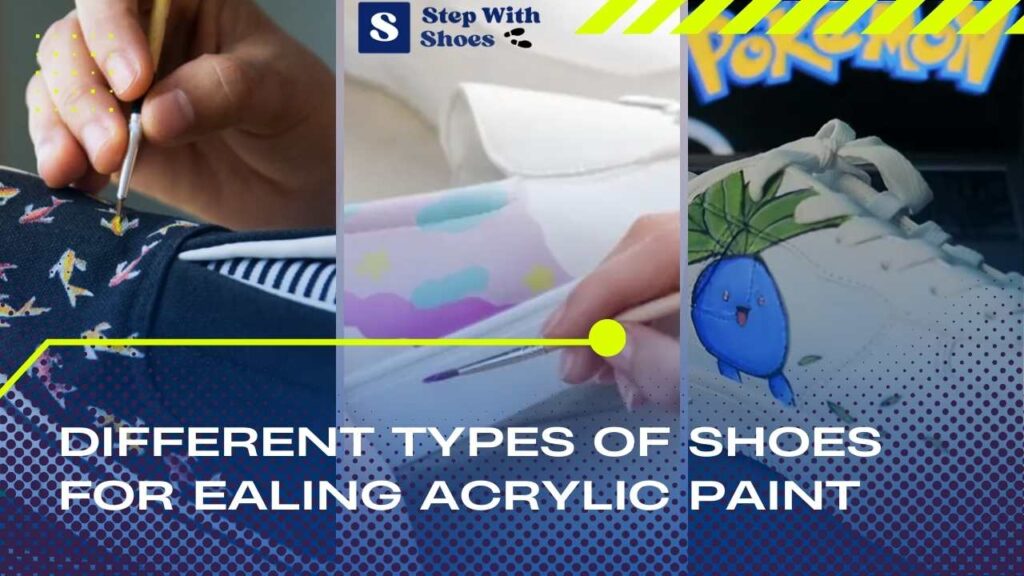
How to Seal Acrylic Paint on Leather Shoes
Sealing acrylic paint on leather shoes is crucial to ensure the longevity and vibrancy of your artwork. Leather shoes offer a smooth and durable surface for acrylic painting. After you’ve finished your acrylic design, allow it to dry completely for at least 24 hours. Once the paint is dry, it’s time to choose the right sealant. For leather shoes, it’s best to use a sealant specifically designed for leather surfaces. A leather sealer will maintain the flexibility of the material, preventing cracks and peeling. Apply the leather sealant using a soft brush or a cloth, covering the painted areas evenly. Allow it to dry as per the product’s instructions, typically overnight.
How to Seal Acrylic Paint on Canvas Shoes
Canvas shoes are popular for painting due to their breathable and flexible nature. To seal acrylic paint on canvas shoes, first, ensure your paint is thoroughly dry, typically within 24 hours. For canvas, you have several options for sealants. Fabric sealers are a good choice for canvas, as they are flexible and durable, maintaining the fabric’s texture. Apply the fabric sealer evenly to the painted area, using a brush or a sponge. Multiple thin layers are often better than one thick coat, as this helps prevent cracking. Allow each layer to dry before applying the next. Remember to pay extra attention to the seams and edges of the painted design to ensure complete coverage. Once you’ve applied the sealer, let it cure for the recommended time.
How to Seal Acrylic Paint on Sneakers
Sealing acrylic paint on sneakers can turn your plain shoes into customized art. Sneakers typically have both fabric and rubber or synthetic parts, so the process is a bit more complex. First, let your acrylic paint dry for about 24 hours. For the fabric parts, use a fabric sealer, as mentioned in the canvas shoe section. Apply it evenly, and make sure to protect any rubber or synthetic areas from the sealer. For the rubber or synthetic components, a clear acrylic spray sealant can work well. Mask off the fabric parts, so you don’t overspray onto your painted design and then apply the clear acrylic spray in thin, even coats. Remember that protecting the sole and the surrounding area is essential. Allow the entire shoe to dry and cure, following the product’s instructions, before wearing them. This combination of sealants will ensure your design remains vibrant and your sneakers stay comfortable.
Preparing The Shoes And Surface
Cleaning And Prepping The Shoes Before Painting
Before you start applying acrylic paint to your shoes, it’s essential to prepare both the shoes and the surface to ensure the best results. Follow these steps to clean and prep your shoes:
- Remove any dirt or dust: Begin by gently wiping off any dirt or dust from the shoes using a clean cloth or sponge. This step is crucial as it helps the paint adhere better to the surface.
- Clean with mild soap and water: Fill a basin or sink with lukewarm water and add a small amount of mild soap. Dip a soft cloth or sponge in the soapy water and gently scrub the shoes, paying attention to any stained or dirty areas. Avoid using harsh chemicals or abrasive cleaners that may damage the shoes.
- Rinse and dry thoroughly: After cleaning, rinse the shoes thoroughly with clean water to remove any soap residue. Pat them dry using a clean towel and allow them to air dry completely. It’s important to ensure that there is no moisture remaining before moving on to the next step.
Techniques For Priming The Shoes For Better Paint Adhesion
To enhance the adhesion of the acrylic paint and create a durable finish on your shoes, consider using the priming techniques listed below:
- Apply a base coat: Start by applying a base coat of acrylic paint in a color similar to your desired final design. This base coat will not only improve the adhesion of subsequent layers of paint but also help create an even surface for better paint distribution.
- Use a primer: Applying a primer designed specifically for acrylic paint can further enhance its adhesion to the shoes. Primer acts as a bonding agent between the paint and the shoe material, ensuring a strong and long-lasting finish. Follow the manufacturer’s instructions for the appropriate application technique and drying time.
- Sand the surface: If your shoes have a glossy or smooth finish, lightly sanding the surface can help create texture and improve paint adhesion. Use fine-grit sandpaper and gently rub it over the shoe’s surface in a circular motion. This process helps remove any shiny or slick layer, allowing the paint to adhere better.
Ensuring A Smooth And Even Surface For Painting
To achieve a flawless finish on your painted shoes, it’s important to ensure a smooth and even surface. Follow these steps to prepare the shoes for painting:
- Fill in any imperfections: If your shoes have any scratches, scuffs, or other imperfections, use a suitable filler to level out the surface. Apply the filler with a putty knife and smooth it out, ensuring it blends seamlessly with the shoe material. Allow the filler to dry completely before proceeding.
- Sand the filled areas: Once the filler is dry, use fine-grit sandpaper to gently sand the filled areas to create a smooth and even surface. Be careful not to over-sand or damage the shoe material. Wipe away any dust with a clean cloth before moving on.
- Apply a primer or base coat: As mentioned earlier, applying a primer or a base coat of acrylic paint is essential to create a uniform surface. This step will help the subsequent layers of paint adhere better and ensure consistent color coverage.
By properly cleaning, prepping, and priming your shoes, you’ll set yourself up for success when it comes to sealing acrylic paint on them. These initial steps will ensure excellent adhesion, durability, and a beautifully finished product. So, let’s get ready to unleash your creativity and transform those dull shoes into eye-catching works of art! Remember, the key is in the preparation.
Applying And Sealing Acrylic Paint On Shoes
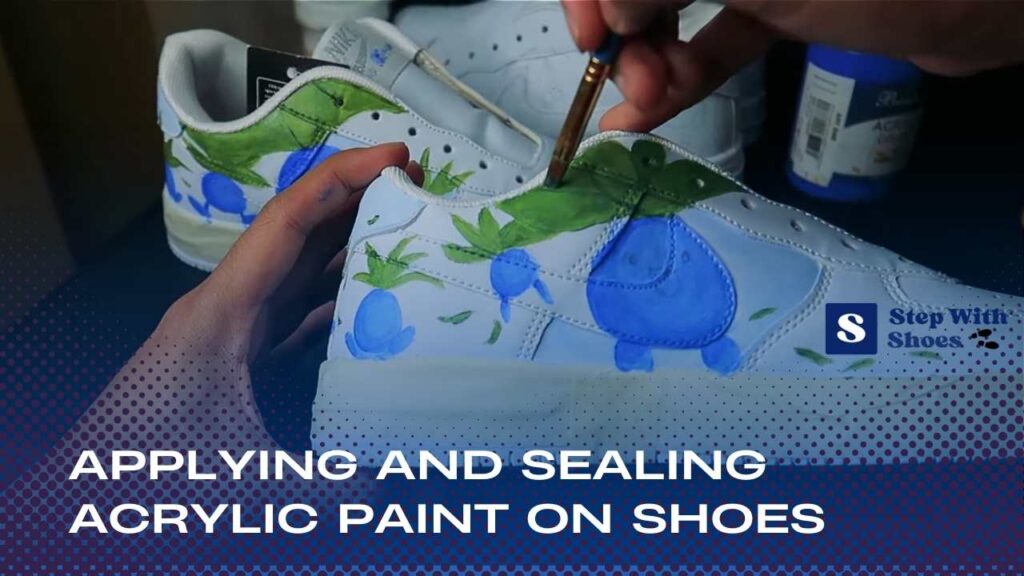
Acrylic paint is a versatile medium that can add a unique touch to your shoes. Whether you want to customize an old pair or give a fresh look to a new one, sealing the acrylic paint is essential for ensuring long-lasting results.
In this section, we will guide you through the step-by-step instructions for properly applying acrylic paint on shoes, share tips for achieving various decorative techniques, and highlight the importance of sealing acrylic paint.
Step-By-Step Instructions For Properly Applying Acrylic Paint On Shoes:
- Prepare your shoes: Thoroughly clean the shoes to remove any dirt or debris. Use a mild soap and water solution and a soft brush to gently scrub the surface. Allow the shoes to dry completely before moving on to the next step.
- Choose the right paint: Select high-quality acrylic paint designed specifically for fabric or leather. This will ensure better adhesion and durability. Acrylic paints come in various colors and finishes, so pick the ones that best suit your design.
- Protect the surrounding area: To avoid any accidental spills or splatters, lay down a newspaper or a plastic sheet to protect your workspace. Additionally, using masking tape to cover areas you don’t want to be painted can help create cleaner lines and edges.
- Start with a base coat: Apply a thin layer of acrylic paint as a base coat using a soft brush or sponge. This will help the subsequent layers adhere better and provide a smooth surface for your design. Allow the base coat to dry completely before proceeding.
- Create your design: Use fine brushes, sponges, or even toothpicks to apply the acrylic paint in the desired patterns or designs. Experiment with different techniques such as stippling, splattering, or blending colors to achieve unique effects. Allow each layer to dry before adding additional details or colors.
- Let it cure: Once your design is complete, allow the paint to dry and cure for at least 24 hours. This ensures that the paint fully bonds to the shoe material.
- Seal the paint: To protect your artwork and make it more durable, apply a sealant specifically designed for acrylic paint. This will help to prevent chipping, fading, or cracking. Follow the manufacturer’s instructions for the best application method.
Tips For Achieving Various Decorative Techniques:
- Stippling: Dip a dry brush into the paint and gently tap it on the shoe surface to create small dots or specks. Vary the pressure and color intensity for a textured effect.
- Splattering: Load a toothbrush with paint and run your thumb across the bristles to create a spray of paint droplets. Experiment with different flicking motions and colors to achieve desired splatter patterns.
- Blending colors: Apply two or more colors of acrylic paint side by side and use a brush or sponge to blend them together. Gradually mix the colors until you achieve the desired gradient or ombre effect.
- Layering: Apply multiple layers of paint, allowing each layer to dry before adding the next. This technique can create depth and dimension to your design.
- Adding details: Use fine brushes or toothpicks to add intricate details such as lines, shapes, or highlights. Take your time and have a steady hand for precise work.
Understanding The Importance Of Sealing Acrylic Paint For Long-Lasting Results:
Sealing acrylic paint not only protects your artwork but also enhances its longevity. Here’s why sealing is crucial:
- Protection: A sealant acts as a protective barrier, preventing the paint from getting scratched, chipped, or damaged due to regular wear and tear.
- Durability: Sealing the acrylic paint makes it more resistant to water, dirt, uv rays, and other external factors that could cause fading or discoloration.
- Flexibility: Shoes undergo frequent bending and flexing, and a proper sealant ensures that the paint remains flexible and doesn’t crack or peel off over time.
- Enhanced colors: Some sealants can enhance the vibrancy of the paint colors, making them appear more vivid and long-lasting.
By following these step-by-step instructions and embracing various decorative techniques, you can create stunning designs on your shoes with acrylic paint. Don’t forget to seal your artwork for protection and longevity. Now, you’re ready to step out in style with your customized shoes!
Selecting The Correct Sealant For Acrylic Paint
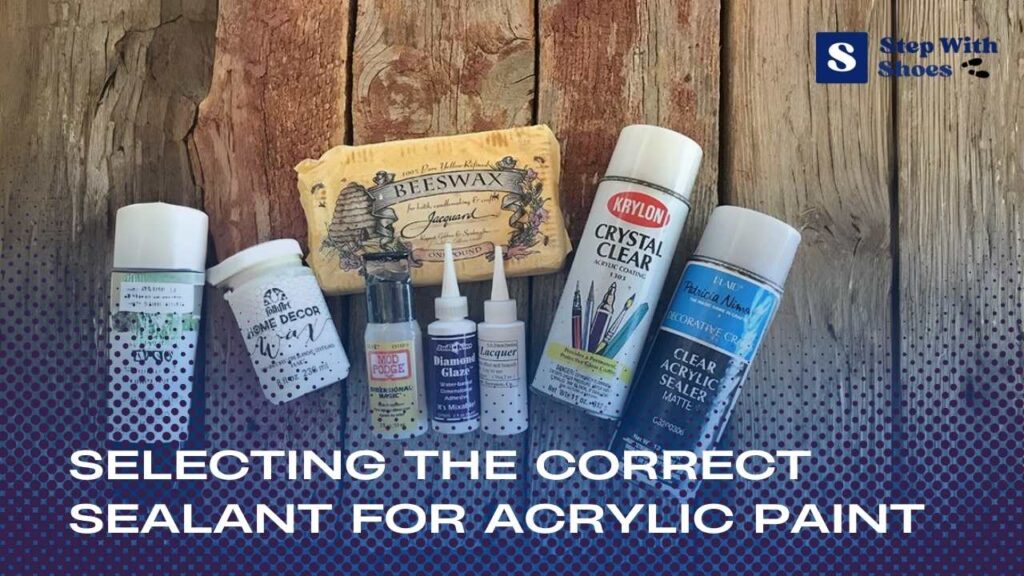
Acrylic paint has become a popular choice for customizing shoes, adding a unique touch to your footwear. However, to ensure your designs stay vibrant and last longer, it is essential to seal the acrylic paint properly. With a variety of sealant options available, it can be overwhelming to choose the correct one for your shoes.
In this section, we will explore different types of sealants and the factors to consider when selecting the most suitable option.
Different Types Of Sealants Available For Protecting Acrylic Paint
When it comes to sealing acrylic paint on shoes, there are several sealant options to choose from. Each type has its own characteristics and application methods. Here are the common sealants used for protecting acrylic-painted shoes:
- Acrylic varnish: Provides a glossy finish and offers good protection against water and uv damage.
- Mod podge: A versatile sealant that can be used as a glue, sealer, and finish. It comes in various finishes, including matte, glossy, and satin.
- Angelus acrylic finisher: Specifically designed for sealing acrylic paint on leather shoes. It offers durable protection and comes in different finishes such as matte and high gloss.
- Fabric sealant: Suitable for sealing acrylic paint on fabric shoes. It provides a flexible and waterproof barrier.
Pros And Cons Of Each Sealant Option For Shoes
To help you make an informed decision, let’s take a closer look at the pros and cons of each sealant option:
- Acrylic varnish:
- Pros:
- Provides a glossy finish that enhances the vibrancy of the colors.
- Offers protection against water damage and uv fading.
- Easy to apply with a brush or spray.
- Cons:
- Can be relatively expensive compared to other sealant options.
- May cause slight color changes or darkening of the paint.
- Mod podge:
- Pros:
- Versatile and available in various finishes to suit your desired look.
- Works well on both porous and non-porous surfaces, including fabric and leather shoes.
- Affordable and widely accessible.
- Cons:
- Not as durable as some other sealants, especially in high-traffic areas.
- Can result in a slightly tacky finish if not applied properly.
- Angelus acrylic finisher:
- Pros:
- Specifically formulated for sealing acrylic paint on leather shoes.
- Offers long-lasting protection against scuffs, scratches, and water damage.
- Comes in different finishes to achieve the desired look.
- Cons:
- Limited application to leather shoes only.
- Relatively higher price point compared to other sealants.
- Fabric sealant:
- Pros:
- Designed specifically for sealing acrylic paint on fabric shoes.
- Provides a flexible barrier that does not crack or peel.
- Water-resistant and helps retain the fabric’s softness.
- Cons:
- Limited application to fabric shoes only.
- Requires multiple coats for optimal protection.
Factors To Consider When Choosing A Sealant Based On The Shoes’ Purpose And Desired Finish
Before selecting a sealant for your acrylic-painted shoes, consider the following factors:
- Shoe material: Different sealants work best on specific materials. Ensure the sealant is compatible with the shoe material, such as leather or fabric.
- Desired finish: Decide whether you want a glossy, matte, or satin finish. Each sealant offers different finish options, so choose one that complements your design.
- Durability: Consider the level of wear and tear your shoes will endure. High-traffic shoes may require a more durable sealant for long-lasting protection.
- Application method: Some sealants are easier to apply with a brush, while others work well with a spray. Choose the application method that suits your preference and comfort level.
- Environmental factors: If you’ll be wearing the shoes in wet conditions or under direct sunlight, opt for a sealant that provides water and uv protection.
By considering these factors and understanding the pros and cons of each sealant option, you can confidently select the correct sealant for your acrylic-painted shoes. Sealants not only enhance the appearance of your designs but also ensure their longevity, allowing you to step out in style with customized and protected footwear.
Proper Techniques For Sealing Acrylic Paint On Shoes
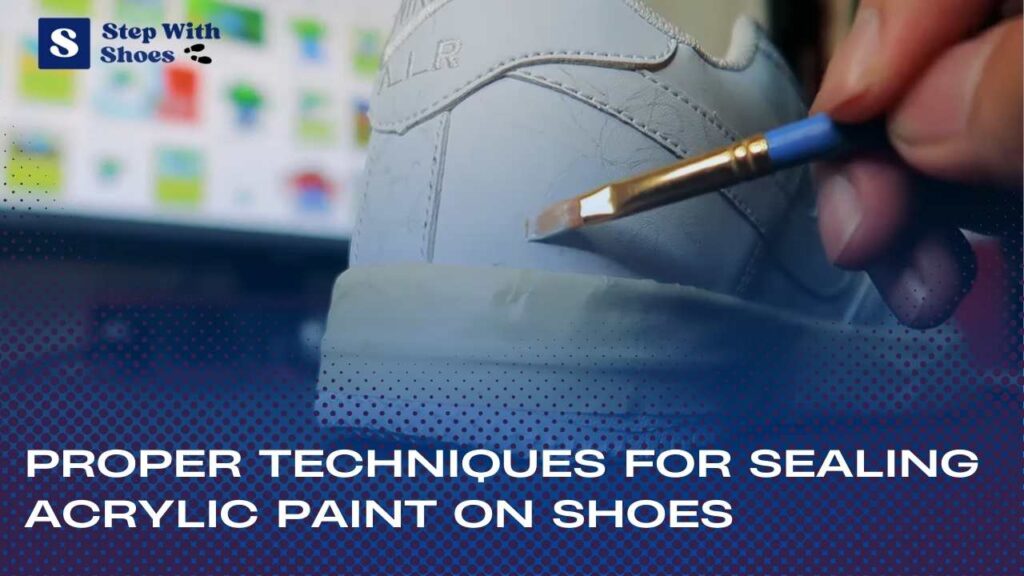
Acrylic paint is a popular choice for customizing shoes due to its vibrant colors and versatility. However, to ensure your artwork stands the test of time, it’s crucial to properly seal the paint. In this section, we will discuss the step-by-step process of sealing acrylic paint on shoes, as well as techniques to ensure an even application of the sealant and prevent cracks, smudges, and fading.
Step-By-Step Guide To Sealing Acrylic Paint On Shoes
Applying a sealant to your acrylic paint not only protects the artwork but also enhances its durability. To seal acrylic paint on shoes, follow these simple steps:
- Clean the surface: Before sealing, make sure to clean the shoes thoroughly. Use a mild detergent or soap and warm water to remove any dirt, dust, or oil residue. Allow the shoes to dry completely before proceeding.
- Choose the right sealant: There are various sealants available in the market, such as acrylic sealers, spray sealers, or liquid varnishes. Select a sealant specifically designed for use on painted surfaces, ensuring compatibility with acrylic paint.
- Prepare the shoes: If you want to seal the entire shoe, protect any areas you don’t want to seal, such as the soles or other non-painted sections. You can use masking tape or a barrier cream to prevent the sealant from reaching unwanted areas.
- Apply the sealant: Shake the sealant well, ensuring proper mixing of the components. Start with a thin layer, applying it evenly over the painted surface using a soft brush or sponge. Allow the first coat to dry as per the manufacturer’s instructions.
- Repeat the process: Apply additional coats of sealant, allowing each layer to dry completely before adding the next. Multiple thin coats are preferable over a single thick coat, as it provides better protection and prevents the paint from cracking.
Ensuring An Even Application Of The Sealant
To ensure a smooth and even application of the sealant, consider the following techniques:
- Apply light pressure: Use a gentle touch while applying the sealant to avoid smudging or disturbing the underlying paint layers.
- Use broad strokes: Utilize long, sweeping strokes instead of short, hasty ones to achieve an even coverage across the shoes.
- Allow drying time: Patience is key. Allow sufficient drying time between each coat to avoid streaks or unevenness in the sealant.
Tips For Preventing Cracks, Smudges, And Fading Of The Paint
To prevent cracks, smudges, and fading of the acrylic paint on your shoes, keep these tips in mind:
- Choose quality materials: Opt for high-quality acrylic paint and sealants that are specifically formulated for durable adhesion and protection.
- Avoid excess moisture: Ensure the shoes are not exposed to excessive moisture, as it can lead to paint damage. Avoid wearing them in heavy rain or submerging them in water.
- Handle with care: Treat your custom-painted shoes gently to prevent accidental scratches or chipping. Avoid dragging your feet or banging the shoes against hard surfaces.
- Store properly: When not wearing your painted shoes, store them in a cool, dry place away from direct sunlight or extreme temperatures. This helps to preserve the vibrancy of the paint for longer periods.
- Touch up when needed: Keep some spare acrylic paint handy to touch up any areas that may get damaged over time. This will ensure your shoes always look their best.
By following these proper techniques for sealing acrylic paint on shoes, you can enhance the longevity and appearance of your custom artwork. With the right sealant and careful application, you can enjoy your personalized shoes for a long time to come.
Curing And Drying Times For Sealed Acrylic Paint On Shoes
Understanding The Importance Of Allowing Sufficient Drying And Curing Time
When it comes to sealing acrylic paint on shoes, giving it enough time to fully dry and cure is crucial. Rushing this process can result in smudging, flaking, or even complete failure of the sealant. Therefore, it is essential to understand the importance of allowing sufficient drying and curing time.
Here are the key points to keep in mind:
- Drying time: The drying time for sealed acrylic paint on shoes can vary depending on several factors, including the thickness of the paint layers, humidity levels, and temperature. It is recommended to let the shoes air dry for at least 24 to 48 hours before applying any sealant. This will ensure that the paint has had enough time to settle and dry properly.
- Curing time: While drying time refers to when the paint is superficially dry, curing time refers to when the paint has fully hardened and bonded with the surface. For sealed acrylic paint on shoes, the curing process can take several weeks to achieve its maximum durability. It is advised to give the shoes at least 2 to 3 weeks of curing time before subjecting them to heavy wear or exposure to water.
- Patience is key: It’s essential to be patient during the drying and curing process. Rushing can lead to undesirable results and compromise the longevity of the paint sealant. Therefore, it is always better to wait longer than necessary than to rush and risk ruining your hard work.
Recommended Drying Techniques To Expedite The Process Without Compromising Results
Waiting for paint to dry can be a test of patience, but there are a few techniques you can use to expedite the drying process without compromising the final results. Here are some recommended drying techniques:
- Use a fan or air circulation: Place a fan or increase air circulation in the room to promote faster evaporation of moisture from the painted shoes. This can help speed up the drying process.
- Thin layers: Applying multiple thin layers of acrylic paint instead of thick coats will dry more quickly and evenly. Thick layers take longer to dry and are more prone to cracking or not fully curing.
- Warm, dry environment: Choose a warm and dry area for the shoes to dry. Avoid humid or cold conditions as they can slow down the drying process and affect the quality of the sealant.
- Heat source: You can use a hairdryer on a low heat setting to gently blow warm air over the painted shoes. Keep the dryer at a safe distance to prevent overheating the paint or causing bubbling.
Remember, even with these techniques, it is still important to allow a sufficient amount of time for the paint to thoroughly dry before moving on to the sealing process.
Duration And Optimal Conditions For Curing Sealed Acrylic Paint On Shoes
Curing sealed acrylic paint on shoes is a critical step that ensures the longevity and durability of the paint. Here’s what you need to know about the duration and optimal conditions for curing:
- Duration: Although the drying time may take only a few days, it is recommended to give the sealed acrylic paint on shoes at least 2 to 3 weeks for proper curing. This extended period allows the paint to fully bond with the shoe surface and reach its maximum strength.
- Optimal conditions: To achieve the best curing results, it is advised to keep the painted shoes in a cool, dry area with good ventilation. Avoid exposing them to excessive heat, moisture, or direct sunlight, as these conditions can interfere with the curing process and compromise the sealant’s durability.
- Test before heavy use: Once the curing period is over, it’s a good idea to do a small test before subjecting the shoes to heavy wear. This can involve gently rubbing or scratching the sealed area to ensure the paint has fully cured and is not easily damaged.
By allowing sufficient time for both drying and curing, you can ensure that your sealed acrylic paint on shoes will not only look great but also withstand the test of time. Remember to follow these recommended techniques and conditions to achieve the best results while preserving the integrity of your artwork.
Maintaining And Caring For Sealed Acrylic Painted Shoes
Acrylic paint is a popular choice for customizing and adding a personal touch to shoes. Once you’ve completed your masterpiece, it’s important to properly care for and maintain the sealed acrylic paint to ensure it lasts a long time. In this section, we will discuss the key routines and protective measures you should take to extend the lifespan of your painted shoes.
We’ll also explore touch-up techniques for addressing minor wear and tear.
Proper Cleaning And Maintenance Routines To Extend The Lifespan Of The Painted Shoes:
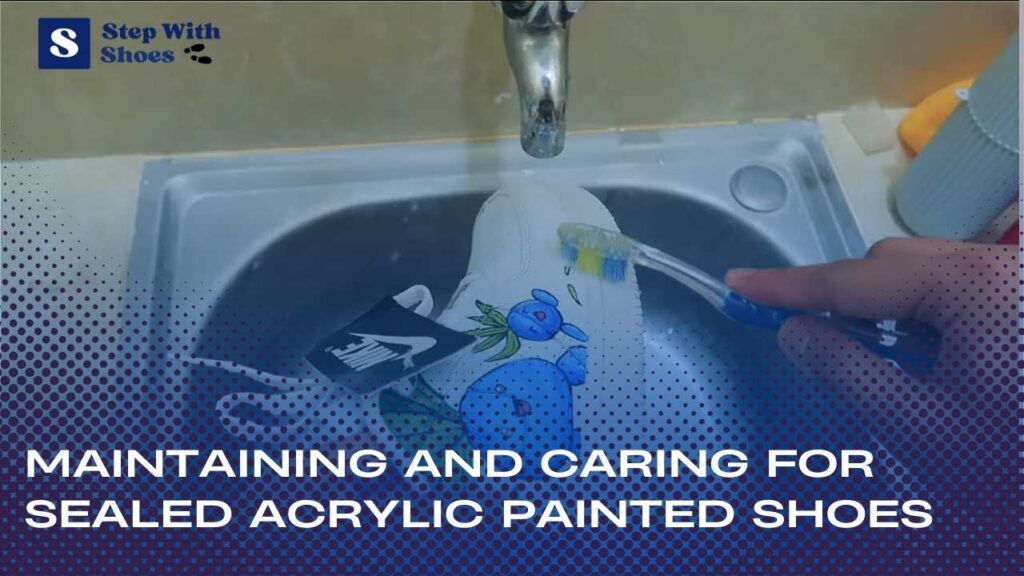
- Wipe down the shoes regularly with a soft, damp cloth to remove dust and dirt. This helps prevent them from settling into the paint and causing damage.
- Avoid using harsh cleaning agents or abrasive materials that could strip the sealant or fade the paint. Stick to mild soap and water for regular cleaning.
- Allow the shoes to air dry naturally after cleaning. Avoid using high heat sources as they can disrupt the sealant and cause the paint to crack or peel.
- Store your painted shoes in a cool, dry place away from direct sunlight. Excessive heat and uv rays can degrade the sealant and fade the paint over time.
Protective Measures To Prevent Damage To The Sealed Paint:
- Apply a clear protective sealant over the acrylic paint to enhance its durability and resistance to wear and tear. Choose a sealant specifically designed for use on fabric or leather.
- Use a soft-bristle brush or sponge to apply the sealant evenly. Ensure you cover the entire painted surface, including the edges and seams.
- Allow the sealant to fully dry according to the manufacturer’s instructions before wearing or handling the shoes.
- Consider adding an additional layer of protection by using a waterproof spray or water repellent product. This can help shield the paint from moisture and stains, ensuring it stays vibrant and intact.
Touch-Up Techniques For Addressing Minor Wear And Tear:
- Keep a small supply of the original acrylic paint colors used for your shoes. This way, you can easily touch up any minor scratches or chips that may occur over time.
- Use a fine-tipped paintbrush to carefully fill in the affected area with the matching paint color. Take your time to ensure a seamless blend with the existing design.
- Allow the touch-up paint to dry completely before applying a new layer of sealant over the repaired area.
- If the damage is more extensive, you may need to consider repainting the entire shoe or seeking professional help to restore the design.
Maintaining and caring for sealed acrylic painted shoes involves proper cleaning and maintenance routines, protective measures to prevent damage, and touch-up techniques for addressing wear and tear. By following these guidelines, you can ensure that your custom masterpiece stays vibrant and lasts for a long time.
So, embrace the creativity, rock your unique shoes, and keep them looking fresh with these simple care tips!
Troubleshooting Common Issues With Sealed Acrylic Paint On Shoes
Acrylic paint is a versatile and popular choice for customizing shoes. It offers vibrant colors and a durable finish when properly sealed. However, even with the best techniques, issues can sometimes arise. In this section, we’ll discuss some common problems that can occur with sealed acrylic paint on shoes and provide effective solutions to fix them.
Identifying And Addressing Common Problems Such As Cracking, Peeling, Or Discoloration
- Cracking: If you notice cracking in the sealed acrylic paint, it may be due to a few reasons:
- Insufficient curing time: Ensure that you have allowed enough time for the paint to dry and cure before applying the sealant.
- Incompatible materials: Make sure that the sealant you are using is compatible with acrylic paint. Some sealants may not adhere well to certain types of acrylic paint.
- Applying too thickly: Applying multiple thick layers of paint can lead to cracking. Try using thin and even layers instead.
- Peeling: Peeling is another common issue encountered when sealing acrylic paint on shoes. Here’s how you can address it:
- Inadequate surface preparation: Properly clean and prepare the shoe surface before applying the paint. Remove any dirt, oil, or previous coatings to enhance adhesion.
- Lack of flexibility: Acrylic paint can become brittle over time, causing it to crack and peel. Consider using a sealant that offers flexibility or add a fabric or leather medium to the paint for greater flexibility.
- Discoloration: If you notice any discoloration in the sealed acrylic paint, follow these steps to tackle the issue:
- Incompatible sealant: Some sealants can alter the color of the paint, leading to discoloration. Before applying the sealant, test it on a small, inconspicuous area to ensure it doesn’t affect the color.
- Exposure to sunlight: Prolonged exposure to sunlight can cause the paint to fade or change color. If possible, store your painted shoes in a cool, dark place when not in use.
Effective Solutions For Fixing Mistakes Or Imperfections In The Sealed Paint
- Mistakes happen, but fortunately, there are ways to fix them. Here are some effective solutions for fixing mistakes or imperfections in sealed acrylic paint on shoes:
- Spot touch-ups: If you spot any small areas that require touch-ups, use a fine brush or a paint pen to carefully fill in the gaps with matching paint.
- Repainting the area: For larger mistakes or imperfections, consider repainting the entire area using the same techniques and materials as before. Make sure to sand down the affected area and remove any loose paint before applying the new paint.
- Adding additional coatings: If the mistake or imperfection is not too noticeable, you can try applying an additional layer of sealant on top to minimize its appearance.
Tips For Troubleshooting Specific Issues Based On The Sealant Used
- Different types of sealants may pose specific challenges or have unique requirements. Here are some tips to troubleshoot specific issues based on the sealant used:
- Spray sealant: If you’re using a spray sealant, always apply it in thin and even layers, holding the can about 10-12 inches away from the shoe surface. Avoid spraying too close or in heavy bursts, as this can cause drips or pooling.
- Brush-on sealant: When using a brush-on sealant, ensure that the brush strokes are smooth and even to achieve a seamless finish. Remove any air bubbles that may form by lightly blowing on the wet sealant or using a hairdryer set on low.
- Heat-set sealant: Heat-set sealants require additional steps for activation. Follow the manufacturer’s instructions carefully, using an iron or heat gun to heat-set the paint. This step is crucial to ensure the durability and longevity of the sealed paint.
By identifying and addressing common problems, implementing effective solutions for imperfections, and utilizing troubleshooting tips specific to the sealant used, you can overcome challenges and create beautifully sealed acrylic paint on your shoes.
Inspiration And Ideas For Acrylic Paint Shoe Designs
Showcasing Various Creative And Artistic Designs On Painted Shoes
When it comes to painting shoes with acrylic paint, the possibilities are endless. From vibrant colors to intricate patterns, you can truly unleash your creativity and turn bland kicks into wearable art. Here are some key points to consider when showcasing your unique designs on painted shoes:
- Customization at its best: Painting your shoes allows you to express your individual style and stand out from the crowd. Whether you prefer bold and colorful designs or subtle and intricate patterns, the choice is yours.
- Mix and match: Experiment with different colors and techniques to create eye-catching designs. Consider blending colors together or using contrasting shades to create a vibrant impact.
- Stencils and patterns: If you’re not confident in your freehand skills, stencils and patterns can be your best friends. They offer a precise way to create intricate designs and add depth to your painted shoes.
- Personal touch: Use your shoes as a canvas to reflect your passions, hobbies, or favorite motifs. Incorporate elements that resonate with you, whether it’s nature-inspired artwork, pop culture references, or abstract designs.
- Embellishments and textures: Take your painted shoes to the next level by incorporating embellishments and textures. Think glitter, rhinestones, fabric patches, or even textured paint to add dimension and visual interest.
- Surface preparation: Before you start applying acrylic paint, make sure to clean and prepare the surface of your shoes. Remove any dirt, grease, or old paint, and consider using a base coat or primer for better adhesion and longevity.
Sources Of Inspiration For Personalized Shoe Customization
Finding inspiration can sometimes be a daunting task, especially when you’re venturing into the world of personalized shoe customization. Here are some sources to spark your creativity and help you find ideas for your next acrylic paint shoe design:
- Social media platforms: Browse through platforms like instagram, pinterest, or tiktok for an endless array of shoe customization ideas. Follow artists, fashion influencers, or hashtags related to painted shoes to discover unique designs and trending styles.
- Art and design exhibitions: Visit local art galleries or attend design exhibitions to gain inspiration from established artists. Their unique techniques and creative approaches can inspire your own shoe customization journey.
- Nature and the world around you: Take a walk in nature or explore your surroundings. Pay attention to colors, patterns, and textures that catch your eye. From floral blooms to architectural details, the world is filled with inspiration waiting to be translated onto your shoes.
- Fashion trends: Keep an eye on current fashion trends and adapt them to your shoe designs. Look for popular colors, patterns, or motifs, and incorporate them in a way that reflects your personal style.
- Personal experiences and memories: Draw inspiration from your own experiences and memories. It could be a favorite childhood cartoon character, a memorable vacation, or a meaningful symbol. These personal touches will make your painted shoes truly unique and special.
How To Adapt Popular Trends And Styles To Acrylic Paint Shoe Designs
Staying on top of popular trends and styles can help you create acrylic paint shoe designs that are both fashionable and unique. Here’s how you can adapt the latest trends to your shoe customization projects:
- Research and observation: Stay updated on the latest fashion trends by reading fashion magazines, following fashion bloggers, or browsing online fashion websites. Analyze runway shows and street styles to identify recurring themes, colors, and patterns.
- Color selection: Choose colors that align with current color trends. For example, if pastel shades are in fashion, incorporate them into your shoe designs. Experiment with popular color combinations or create your own unique palettes.
- Pattern play: Incorporate trendy patterns into your shoe designs, such as animal prints, geometric shapes, or floral motifs. Don’t be afraid to combine patterns or create your own unique patterns that reflect your personal style.
- Minimalism or maximalism: Embrace minimalism by choosing clean lines, simple designs, and monochromatic color schemes. Alternatively, go for bold and maximalist designs with vibrant colors and intricate details. Adapt your shoe designs based on your preference and the current trends.
- Mix and match techniques: Experiment with different painting techniques, such as color blocking, ombre effects, or gradient blending. Combine multiple techniques to create visually stunning and unique shoe designs.
- Collaborations and crossovers: Look for opportunities to collaborate with other artists or designers. You can combine your skills with a fashion designer, illustrator, or even a fellow shoe customization enthusiast to create innovative and trendsetting designs.
Remember, acrylic paint on shoes is a versatile medium that allows you to unleash your creativity and express your personal style. Experiment, have fun, and let your imagination run wild as you create your own unique and personalized shoe designs.
Frequently Asked Questions About Sealing Acrylic Paint On Shoes
Answering Common Queries About Sealing Acrylic Paint On Shoes
When it comes to sealing acrylic paint on shoes, many people have questions about the process and its effectiveness. In this section, we will address some frequently asked questions to help you better understand how to seal your painted shoes.
- What is the purpose of sealing acrylic paint on shoes?
Sealing acrylic paint on shoes serves two main purposes: to protect the paint from chipping, cracking, or peeling, and to create a barrier that prevents the paint from coming into direct contact with external elements like water, dirt, or oils.
- What type of sealant should i use on my painted shoes?
There are various sealants available for sealing acrylic paint on shoes. Some popular options include acrylic sealers, fabric sealers, or clear spray paints specifically designed for outdoor use. It’s important to choose a sealant that is compatible with acrylic paint and suitable for the shoe material.
- How many coats of sealant should i apply?
The number of coats needed to seal acrylic paint on shoes may vary depending on the desired level of protection and the specific sealant used. Generally, it is recommended to apply at least two to three thin coats of sealant, allowing each coat to dry completely before applying the next.
- Do i need to prepare the shoes before sealing the paint?
Yes, proper preparation is crucial for sealing acrylic paint on shoes effectively. Before applying the sealant, ensure that the painted surface is clean, dry, and free from any dust, dirt, or debris. If necessary, use a mild soap and water solution or a gentle cleanser to gently clean the shoes, and let them air dry completely.
Clarifying Misconceptions And Debunking Myths Related To Shoe Painting And Sealing
There are several misconceptions and myths surrounding the process of painting and sealing shoes with acrylic paint. Let’s clarify some of these common misunderstandings to help you navigate through the shoe painting journey with confidence.
- Myth: I can seal acrylic paint on shoes with just a clear nail polish.
Clarification: while clear nail polish may provide a temporary glossy finish, it is not a suitable long-term sealant for painted shoes. Nail polish tends to crack and peel off easily, offering limited protection and durability compared to dedicated sealants designed for acrylic paint.
- Myth: Sealing acrylic paint will make my shoes waterproof.
Clarification: sealing acrylic paint on shoes can offer some level of water resistance but it does not make them completely waterproof. While the sealant acts as a protective barrier against light splashes and moisture, it may not withstand heavy exposure to water or prolonged submersion.
- Myth: Sealing acrylic paint will prevent my shoes from flexing and bending.
Clarification: sealing acrylic paint on shoes does not stiffen or restrict the flexibility of the shoe material. A properly applied sealant should allow the shoes to flex and bend naturally while providing a protective layer that helps prevent the paint from cracking or peeling.
Providing Additional Tips And Advice For Beginners And Experienced Artists Alike
Whether you’re a beginner or an experienced artist, these additional tips and advice will help you achieve the best results when sealing acrylic paint on shoes.
- Properly prepare the shoes before painting: Clean and prep the shoes by removing any factory finishes, applying a base coat, and ensuring the surface is smooth and ready for painting.
- Use high-quality acrylic paint: Invest in good quality acrylic paint that is formulated for use on fabric or leather to ensure vibrant colors and long-lasting results.
- Apply thin and even coats: When painting and sealing shoes, it’s essential to apply thin and even coats of paint and sealant to avoid clumping, drips, and an uneven finish.
- Allow sufficient drying time: Patience is key when it comes to drying painted shoes. Allow each layer of paint and sealant to dry fully before applying the next coat or wearing the shoes.
- Store and care for your painted shoes properly: To prolong the life of your painted shoes, store them in a cool, dry place when not in use, and avoid excessive rubbing or scratching.
Remember, practice makes perfect. Don’t be afraid to experiment and have fun with your shoe painting projects. With the right techniques and sealing methods, you can create stunning, personalized footwear that will turn heads wherever you go.
Frequently Asked Questions For How To Seal Acrylic Paint On Shoes
How Do You Seal Acrylic Paint On Shoes?
To seal acrylic paint on shoes, first clean the shoes with soap and water. Apply a thin, even layer of acrylic sealer using a brush or sponge. Let it dry for 24 hours before wearing the shoes. For added durability, repeat the process and let the sealer cure for a week.
Can I Use Mod Podge To Seal Acrylic Paint On Shoes?
Yes, you can use Mod Podge to seal acrylic paint on shoes. After painting your shoes with acrylic paint and letting it dry, apply a thin, even layer of Mod Podge using a brush or sponge. Let it dry completely before wearing the shoes.
Mod Podge will provide a protective seal and make your design durable.
How Long Does It Take For Acrylic Paint To Dry On Shoes?
Acrylic paint generally dries quickly, but the drying time on shoes can depend on factors like humidity and the thickness of paint layers. In general, it may take around 30 minutes to 1 hour for the paint to dry to touch.
However, it is recommended to wait at least 24 hours before handling or sealing the painted shoes.
Should I Use A Primer Before Painting Shoes With Acrylic Paint?
Using a primer before painting shoes with acrylic paint is recommended as it helps the paint adhere better to the surface and improves its durability. Apply a thin, even layer of primer to the shoes and let it dry completely before applying the acrylic paint.
This will ensure a smoother and more long-lasting finish.
Can I Wash Shoes Painted With Acrylic Paint?
Yes, you can wash shoes painted with acrylic paint, but it’s important to do it carefully. Hand-wash the shoes using mild soap and lukewarm water. Gently scrub the painted areas with a soft brush or sponge. Avoid immersing the shoes in water or using harsh scrubbing tools.
Let them air dry completely before wearing them again.
Conclusion
Sealing acrylic paint on shoes is a crucial step to ensure the longevity and quality of your artwork. By following these simple steps, you can protect your painted shoes from peeling, cracking, and fading. Cleaning the shoes thoroughly before applying the sealant will help ensure a smooth surface.
Additionally, choosing the right sealant, such as a waterproof and flexible one, will provide extra protection against water, dirt, and everyday wear and tear. Applying multiple thin coats and allowing each coat to dry completely will help create a durable finish.
Finally, taking the time to cure the sealant properly will ensure maximum adhesion and durability. So go ahead and seal your acrylic paint on shoes to make your designs last and stay vibrant for a long time. Get creative and show off your unique style with confidence!

